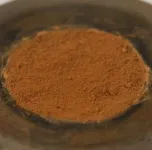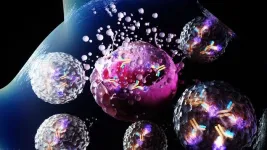(Press-News.org) The Beatles said it best: Love is all you need. And according to new research from The Australian National University (ANU), the same is true in the animal kingdom. Well, at least for mosquitofish – a matchstick-sized fish endemic to Central America and now found globally.
According to the ANU scientists, male mosquitofish possess impressive problem-solving skills and can successfully navigate mazes and other tests. Males that perform better have a higher chance of mating.
Lead author Dr Ivan Vinogradov said male mosquitofish likely evolved better cognitive abilities over time because of the advantage it gave them in finding females and producing offspring – a phenomenon known as “sexual selection”.
“Evolution of intelligence in animals has long been thought to have been driven by natural selection. Animals that were better at problem solving were more adept at gathering food, finding shelter, and avoiding predators and hence lived longer,” Dr Vinogradov said.
“They then passed on these genes to their offspring, helping future generations become smarter over time.
“But there is another explanation for the evolution of intelligence: braininess is an attractive quality to the opposite sex. A better brain might help an animal find more mates, have more sex, and eventually have more babies.
“This suggests that intelligence in mosquitofish partly evolved through sexual selection, where traits that boost mating and fertilisation success become more common over generations. Sexual selection is usually stronger in males than females because in most species there are more males seeking mates than females ready to mate and breed.
“Our study suggests that intelligence in mosquitofish isn’t only driven by their need to find food or avoid predators, but also by the complex challenges of finding love. This shows that, much like humans, love conquers all.”
The researchers measured intelligence of the male mosquitofish by putting them through a series of underwater tests – including navigating mazes, detouring around transparent barriers and learning to remember different coloured spots – offering a reward for the fish that were able to complete the tests.
The team then tracked, over a two-month period, how many offspring each male produced when competing against other males for a female partner to mate with.
After performing more than 2,000 paternity tests, the scientists found that smarter males who successfully navigated the underwater tests mated with more females and produced more offspring than less-intelligent fish that failed the tests.
“Our findings imply that the evolution of cognitive abilities may have been driven by sexual selection for males who gained more mating opportunities,” study co-author Professor Michael Jennions said.
“Something about these males seemingly gave them an edge in securing mating opportunities. Perhaps females recognised and preferred smarter males, or maybe smarter males were better at chasing the females and forcing them to mate, a common, if unpleasant, practice in mosquitofish.
“Future research is needed to observe the males more closely and see how the mating behaviour of smarter and dumber males differs.”
The research is published in Nature Ecology and Evolution. The research team involved scientists from Australia, Germany and South Africa.
END
Smart is sexy: evolution of intelligence partly driven by love
2025-02-25
ELSE PRESS RELEASES FROM THIS DATE:
Have we been wrong about why Mars is red?
2025-02-25
Mars is easily identifiable in the night sky by its prominent red hue. Thanks to the fleet of spacecraft that have studied the planet over the last decades, we know that this red colour is due to rusted iron minerals in the dust. That is, iron bound up in Mars’s rocks has at some point reacted with liquid water, or water and oxygen in the air, similar to how rust forms on Earth.
Over billions of years this rusty material – iron oxide – has been broken down into dust and spread all around the planet by winds, a process that continues today.
But iron ...
Screening & treating maternal psychological health key to improving cardiovascular health
2025-02-25
Statement Highlights:
It is essential for health care professionals to routinely screen pregnant and postpartum women for depression and anxiety, address modifiable risk factors and consider behavioral and pharmacological interventions to improve long-term maternal health outcomes.
Multidisciplinary care teams, including psychologists and other behavioral health professionals, are important to monitor and provide appropriate mental health support during pregnancy and after birth.
The new ...
Childhood trauma increases incidence of heart disease in Black women, Emory study finds
2025-02-25
New research from Emory University indicates that childhood trauma physically alters the hearts of Black women.
The study, which examined the relationship between childhood exposure to trauma and vascular dysfunction among more than 400 Black adults in Atlanta ages 30 to 70, found that women who experienced childhood trauma had a worse vascular function, a preclinical marker of heart disease, while men had none. In addition, the findings show women may be more vulnerable to a larger cumulative stress burden, eliciting varying physiological ...
Why is Mars red? Scientists may finally have the answer
2025-02-25
PROVIDENCE, R.I. [Brown University] — Mars has captivated scientists and the public alike for centuries. One of the biggest reasons is the planet’s reddish hue, earning the third rock from the sun one its most popular nicknames — the “Red Planet.” But what exactly gives the planet its iconic color? Scientists have wondered this for as long as they’ve studied the planet. Today, they may finally have a concrete answer, one that ties into Mar’s watery past.
Results from a new study published in the journal Nature Communications and led by researchers from Brown University and the University of Bern suggest that the water-rich iron mineral ...
Research challenges our understanding of cancer predisposition
2025-02-25
Despite what was previously thought, new research has shown that genetic changes alone cannot explain why and where tumours grow in those with genetic condition neurofibromatosis type 1 (NF-1). Understanding more about the factors involved could, in the future, facilitate early cancer detection in NF-1 patients and even point towards new treatments.
Researchers from the Wellcome Sanger Institute, UCL Great Ormond Street Institute of Child Health, Great Ormond Street Hospital, Cambridge University Hospitals NHS Foundation Trust, and their collaborators, focused on NF-1, a genetic condition that causes ...
What makes cancer cells weak
2025-02-25
One particular challenge in the treatment of cancer is therapy resistance. An international research team has now discovered a mechanism that opens up new treatment strategies for tumours in which conventional chemotherapeutic agents have reached their limits. "Cytotoxic agents from nature lead to an increased incorporation of polyunsaturated fatty acids into the membrane of cancer cells. This makes them more susceptible to ferroptosis, a type of cell death, at a very early stage," reports Andreas Koeberle, a pharmacist at the University of Graz and lead author of the study, which has just been published in the scientific journal Nature ...
Robots learn how to move by watching themselves
2025-02-25
New York, NY—Feb. 25, 2025— By watching their own motions with a camera, robots can teach themselves about the structure of their own bodies and how they move, a new study from researchers at Columbia Engineering now reveals. Equipped with this knowledge, the robots could not only plan their own actions, but also overcome damage to their bodies.
"Like humans learning to dance by watching their mirror reflection, robots now use raw video to build kinematic self-awareness," says study lead author Yuhang Hu, a doctoral student at the Creative Machines Lab at Columbia University, directed by Hod Lipson, James and Sally Scapa Professor of Innovation and chair of the Department ...
MD Anderson researchers develop novel antibody-toxin conjugate
2025-02-25
HOUSTON ― Researchers at The University of Texas MD Anderson Cancer Center have developed a novel antibody-toxin conjugate (ATC) designed to stimulate immune-mediated eradication of tumors. According to preclinical results published today in Nature Cancer, the new approach combined the benefits of more well-known antibody-drug conjugates (ADCs) with those of immunotherapies.
ADCs have emerged as a breakthrough in recent years due to their modular design, which enables precise delivery of therapies to tumors by targeting specific proteins expressed on cancer cells. These conjugates ...
One in ten older South Asian immigrants in Canada have hypothyroidism
2025-02-25
Toronto, ON – A new study published this week in Archives of Gerontology and Geriatrics Plus found that 10% of South Asian immigrants aged 45 and older in Canada had hypothyroidism. After adjustment for a wide range of sociodemographic characteristics and health behaviors, those who had immigrated from South Asia had 77% higher odds of hypothyroidism than those born in Canada.
“To the best of our knowledge, this is the first study to identify a significantly higher odds of hypothyroidism among immigrants of South Asian descent,” says senior author Esme Fuller-Thomson, a Professor at Factor-Inwentash Faculty of Social Work (FIFSW) and Director ...
Substantial portion of cancer patients in early trials access drugs that are later approved
2025-02-25
A new paper in the Journal of the National Cancer Institute, published by Oxford University Press, finds that almost 20% of patients in middle-stage cancer drug trials receive treatment that eventually prove effective enough to get FDA approval. This may have important implications for drug development and clinical trial recruitment.
The development of new medications typically has three stages. In phase 1 trials, researchers assess drugs for safety and dosing (“What is the best tolerated dose for the patient?”). Phase 2 clinical trials determine whether a new drug shows signs of efficacy (“How much does the ...








